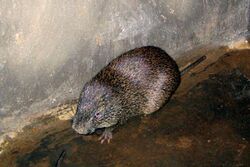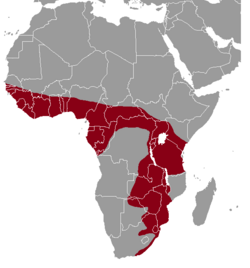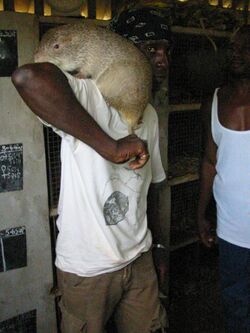Biology:Greater cane rat
| Greater cane rat | |
|---|---|

| |
| Scientific classification | |
| Domain: | Eukaryota |
| Kingdom: | Animalia |
| Phylum: | Chordata |
| Class: | Mammalia |
| Order: | Rodentia |
| Family: | Thryonomyidae |
| Genus: | Thryonomys |
| Species: | T. swinderianus
|
| Binomial name | |
| Thryonomys swinderianus (Temminck, 1827)
| |

| |
The greater cane rat (Thryonomys swinderianus), also known as the grasscutter (in Ghana, Nigeria and other regions of West Africa), is one of two species of cane rats, a small family of African hystricognath rodents.[2] It lives by reed-beds and riverbanks in Sub-Saharan Africa.
Description
Greater cane rats can measure in head-and-body length from 43 to 60 cm (17 to 24 in) with the tail measuring 16 to 19.5 cm (6.3 to 7.7 in). Typical weight is 3.2 to 5.2 kg (7.1 to 11.5 lb), in males averaging some 4.5 kg (9.9 lb), and females at 3.4 to 3.8 kg (7.5 to 8.4 lb). In some cases, greater cane rats can weigh to approximately 7 to 9 kg (15 to 20 lb). They are considered one of the largest rodents in Africa, behind only the Hystrix porcupines.[3][4][5] It has rounded ears, a short nose, and coarse bristly hair. Its forefeet are smaller than its hind feet, each with three toes.
Behaviour
Cane rats live in small groups led by a single male. They are nocturnal and make nests from grasses or burrow underground. Individuals of the species may live in excess of four years. If frightened, they grunt and run towards water.
Interactions with humans
As humans expanded into the cane rat's native habitats, the cane rats likewise expanded from their native reeds into the plantations, particularly the sugar cane plantations from which they derive their name. Their tendency to adopt plantations as habitat, where they feed on agricultural crops such as maize, wheat, sugar-cane and cassava, often earns them the label of agricultural pest. However, the peoples of the region also utilize the cane rat as a food source (as bushmeat), considering the meat a delicacy. Consequently, these rats are beginning to be raised in cages for sale.[6]
References
- ↑ Hoffmann, M. (2008). "Thryonomys swinderianus". IUCN Red List of Threatened Species 2008. https://www.iucnredlist.org/details/21847/0. Retrieved 2013-09-08.
- ↑ Woods, C.A.; Kilpatrick, C.W. (2005). "Infraorder Hystricognathi". in Wilson, D.E.; Reeder, D.M. Mammal Species of the World: A Taxonomic and Geographic Reference (3rd ed.). Johns Hopkins University Press. p. 1545. ISBN 978-0-8018-8221-0. OCLC 62265494. http://www.departments.bucknell.edu/biology/resources/msw3/browse.asp?id=13400090.
- ↑ Van der Merwe, M. (2007). Discriminating between Thryonomys swinderianus and Thryonomys gregorianus. African Zoology, 42(2), 165-171.
- ↑ Mustapha, O. A., Teriba, E. E., Ezekiel, O. S., Olude, A. M., Akinloye, A. K., & Olopade, J. O. (2020). A study of scientific publications on the greater cane rat (Thryonomys swinderianus, Temminck 1827). Animal models and experimental medicine, 3(1), 40-46.
- ↑ Smithers, R. H. (2012). Smithers Mammals of Southern Africa. Penguin Random House South Africa.
- ↑ micro-livestock Micro-livestock: Appropedia - Little-known Small Animals with a Promising Economic Future 7
- Matthews, Jaman. "The Value of Grasscutters," World Ark, (January–February, 2008), pp. 23–24.
External links
- BBC article on "grasscutter" rearing in Ghana
- "The New Livestock: Rodents of Unusual Size in Heifer Projects in Ghana" in World Ark, August, 2012 | Heifer.org[yes|permanent dead link|dead link}}]
Wikidata ☰ Q932685 entry
 |



